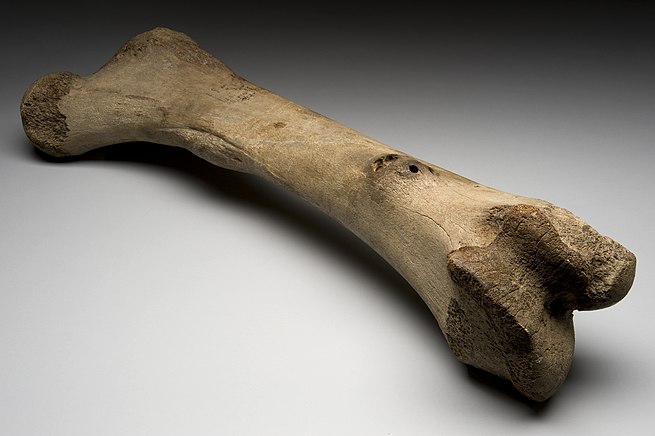
Main Difference
The main difference between Bone and Cartilage is that the Bone is a rigid organs that constitute part of the endoskeleton of vertebrates and Cartilage is a resilient and smooth elastic tissue, rubber-like padding that covers and protects the ends of long bones at the joints
-
Bone
A bone is a rigid organ that constitutes part of the vertebrate skeleton. Bones protect the various organs of the body, produce red and white blood cells, store minerals, provide structure and support for the body, and enable mobility. Bones come in a variety of shapes and sizes and have a complex internal and external structure. They are lightweight yet strong and hard, and serve multiple functions.
Bone tissue (osseous tissue) is a hard tissue, a type of dense connective tissue. It has a honeycomb-like matrix internally, which helps to give the bone rigidity. Bone tissue is made up of different types of bone cells. Osteoblasts and osteocytes are involved in the formation and mineralization of bone; osteoclasts are involved in the resorption of bone tissue. Modified (flattened) osteoblasts become the lining cells that form a protective layer on the bone surface. The mineralised matrix of bone tissue has an organic component of mainly collagen called ossein and an inorganic component of bone mineral made up of various salts. Bone tissue is a mineralized tissue of two types, cortical bone and cancellous bone. Other types of tissue found in bones include bone marrow, endosteum, periosteum, nerves, blood vessels and cartilage.
In the human body at birth, there are over 270 bones, but many of these fuse together during development, leaving a total of 206 separate bones in the adult, not counting numerous small sesamoid bones. The largest bone in the body is the femur or thigh-bone, and the smallest is the stapes in the middle ear.
The Greek word for bone is ὀστέον (“osteon”), hence the many terms that use it as a prefix – such as osteopathy.
-
Cartilage
Cartilage is a resilient and smooth elastic tissue, a rubber-like padding that covers and protects the ends of long bones at the joints, and is a structural component of the rib cage, the ear, the nose, the bronchial tubes, the intervertebral discs, and many other body components. It is not as hard and rigid as bone, but it is much stiffer and much less flexible than muscle. The matrix of cartilage is made up of glycosaminoglycans, proteoglycans, collagen fibers and, sometimes, elastin.
Because of its rigidity, cartilage often serves the purpose of holding tubes open in the body. Examples include the rings of the trachea, such as the cricoid cartilage and carina.
Cartilage is composed of specialized cells called chondrocytes that produce a large amount of collagenous extracellular matrix, abundant ground substance that is rich in proteoglycan and elastin fibers. Cartilage is classified in three types, elastic cartilage, hyaline cartilage and fibrocartilage, which differ in relative amounts of collagen and proteoglycan.
Cartilage does not contain blood vessels (it is avascular) or nerves (it is aneural). Nutrition is supplied to the chondrocytes by diffusion. The compression of the articular cartilage or flexion of the elastic cartilage generates fluid flow, which assists diffusion of nutrients to the chondrocytes. Compared to other connective tissues, cartilage has a very slow turnover of its extracellular matrix and does not repair.
-
Bone (noun)
A composite material consisting largely of calcium phosphate and collagen and making up the skeleton of most vertebrates.
-
Bone (noun)
Any of the components of an endoskeleton, made of bone.
-
Bone (noun)
A bone of a fish; a fishbone.
-
Bone (noun)
A bonefish
-
Bone (noun)
One of the rigid parts of a corset that forms its frame, the boning, originally made of whalebone.
-
Bone (noun)
One of the fragments of bone held between the fingers of the hand and rattled together to keep time to music.
-
Bone (noun)
Anything made of bone, such as a bobbin for weaving bone lace.
-
Bone (noun)
The framework of anything.
-
Bone (noun)
An off-white colour, like the colour of bone.
“color panel|E4D4BA”
-
Bone (noun)
A dollar.
-
Bone (noun)
The wishbone formation.
-
Bone (noun)
An erect penis; a boner.
-
Bone (noun)
A domino or dice.
-
Bone (noun)
clipping of trombone
-
Bone (adjective)
Of an off-white colour, like the colour of bone.
-
Bone (verb)
To removing the bone or bones from.
-
Bone (verb)
To fertilize with bone.
-
Bone (verb)
To put whalebone into.
“to bone stays”
-
Bone (verb)
To make level, using a particular procedure; to survey a level line.
“boning rod”
-
Bone (verb)
To have sexual intercourse with.
-
Bone (verb)
To perform “bone pointing”, a ritual that is intended to bring illness or even death to the victim.
-
Bone (verb)
To study.
“bone up”
-
Bone (verb)
To polish boots to a shiny finish.
-
Bone (verb)
To apprehend, steal.
-
Bone (verb)
To sight along an object or set of objects to check whether they are level or in line.
-
Cartilage (noun)
A type of dense, non-vascular connective tissue, usually found at the end of joints, the rib cage, the ear, the nose, in the throat and between intervertebral disks.
-
Bone (noun)
former name for Annaba
-
Bone (verb)
remove the bones from (meat or fish) before cooking, serving, or selling
“ask your butcher to bone the turkey for you”
-
Bone (verb)
study (a subject) intensively, typically in preparation for something
“she boned up on languages she had learned long ago”
-
Bone (verb)
(of a man) have sexual intercourse with (someone).
